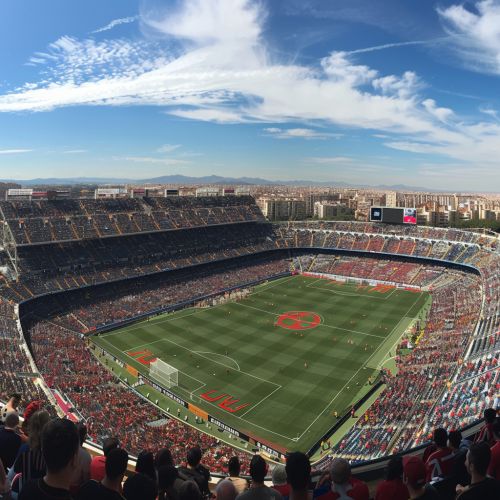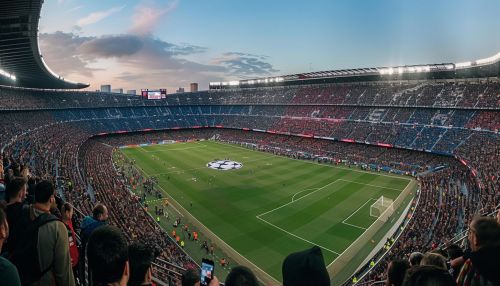Old Trafford: Difference between revisions
(Created page with "== History == Old Trafford, often referred to as the "Theatre of Dreams," is a football stadium located in Greater Manchester, England. It is the home of Manchester United Football Club and has been since its construction was completed in 1910. The stadium was designed by architect Archibald Leitch, who also designed several other notable football stadiums across the United Kingdom. <div class='only_on_desktop image-preview'><div class='image...") |
No edit summary |
||
| (One intermediate revision by the same user not shown) | |||
| Line 3: | Line 3: | ||
Old Trafford, often referred to as the "Theatre of Dreams," is a football stadium located in Greater Manchester, England. It is the home of [[Manchester United F.C.|Manchester United Football Club]] and has been since its construction was completed in 1910. The stadium was designed by architect Archibald Leitch, who also designed several other notable football stadiums across the United Kingdom. | Old Trafford, often referred to as the "Theatre of Dreams," is a football stadium located in Greater Manchester, England. It is the home of [[Manchester United F.C.|Manchester United Football Club]] and has been since its construction was completed in 1910. The stadium was designed by architect Archibald Leitch, who also designed several other notable football stadiums across the United Kingdom. | ||
[[Image:Detail-78929.jpg|thumb|center|A panoramic view of a large football stadium with filled stands.|class=only_on_mobile]] | |||
[[Image:Detail-78930.jpg|thumb|center|A panoramic view of a large football stadium with filled stands.|class=only_on_desktop]] | |||
The stadium's initial capacity was approximately 80,000, making it one of the largest football stadiums in England at the time. However, due to safety regulations that were implemented in the years following its construction, the capacity was reduced to around 44,000 by the 1940s. | The stadium's initial capacity was approximately 80,000, making it one of the largest football stadiums in England at the time. However, due to safety regulations that were implemented in the years following its construction, the capacity was reduced to around 44,000 by the 1940s. | ||
Latest revision as of 04:55, 16 May 2024
History
Old Trafford, often referred to as the "Theatre of Dreams," is a football stadium located in Greater Manchester, England. It is the home of Manchester United Football Club and has been since its construction was completed in 1910. The stadium was designed by architect Archibald Leitch, who also designed several other notable football stadiums across the United Kingdom.


The stadium's initial capacity was approximately 80,000, making it one of the largest football stadiums in England at the time. However, due to safety regulations that were implemented in the years following its construction, the capacity was reduced to around 44,000 by the 1940s.
During the Second World War, Old Trafford suffered significant damage from German bombing raids and was rendered unusable for a period of eight years. During this time, Manchester United were forced to share Maine Road stadium with their local rivals, Manchester City.
Design and Structure
The design of Old Trafford has evolved significantly over the years, with numerous expansions and renovations taking place to increase capacity and improve facilities. The stadium now boasts a seating capacity of over 74,000, making it the second-largest football stadium in the United Kingdom, after Wembley.
The stadium is comprised of four main stands: the Sir Alex Ferguson Stand (formerly known as the North Stand), the East Stand, the South Stand, and the West Stand (also known as the Stretford End). Each stand has multiple tiers, with the Sir Alex Ferguson Stand being the largest with three tiers.
The pitch at Old Trafford measures approximately 105 by 68 metres, which is the maximum size permitted under UEFA regulations. The pitch is surrounded by a running track for athletics events, although this feature is rarely used.
Notable Events
Old Trafford has been the venue for numerous significant events in the history of football. It has hosted matches in the World Cup, the European Championship, and the Champions League, among others.
In addition to football, Old Trafford has also been used for a variety of other sports and events. It has hosted rugby league's Super League Grand Final and the Rugby League World Cup. In 2013, it was used as a venue for the 2013 Rugby League World Cup Final. The stadium has also been used for concerts, with artists such as Bon Jovi, Bruce Springsteen, and the Rolling Stones performing there.
Future Developments
There have been numerous proposals over the years to further expand and develop Old Trafford. The most recent of these involves the expansion of the South Stand, which would increase the stadium's capacity to over 88,000. However, this proposal has yet to be approved and remains a subject of ongoing discussion.
